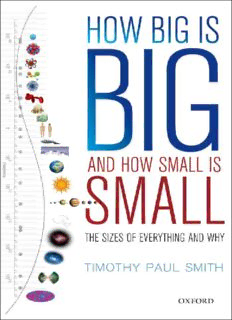
How Big is Big and How Small is Small The Sizes of Everything and Why PDF
Preview How Big is Big and How Small is Small The Sizes of Everything and Why
2 HOW BIG IS BIG AND HOW SMALL IS SMALL The Sizes of Everything and Why by Timothy Paul Smith 3 Great Clarendon Street, Oxford, OX2 6DP, United Kingdom Oxford University Press is a department of the University of Oxford. It furthers the University’s objective of excellence in research, scholarship, and education by publishing worldwide. Oxford is a registered trade mark of Oxford University Press in the UK and in certain other countries c © Timothy Paul Smith 2013 The moral rights of the author have been asserted First Edition published in 2013 Impression: 1 All rights reserved. No part of this publication may be reproduced, stored in a retrieval system, or transmitted, in any form or by any means, without the prior permission in writing of Oxford University Press, or as expressly permitted by law, by licence or under terms agreed with the appropriate reprographics rights organization. Enquiries concerning reproduction outside the scope of the above should be sent to the Rights Department, Oxford University Press, at the address above You must not circulate this work in any other form and you must impose this same condition on any acquirer Published in the United States of America by Oxford University Press 198 Madison Avenue, New York, NY 10016, United States of America British Library Cataloguing in Publication Data Data available 4 Library of Congress Control Number: 2013937705 ISBN 978–0–19–968119–8 Printed and bound by CPI Group (UK) Ltd, Croydon, CR0 4YY Links to third party websites are provided by Oxford in good faith and for information only. Oxford disclaims any responsibility for the materials contained in any third party website referenced in this work. 5 Contents List of Figures List of Tables 1. From Quarks to the Cosmos: An Introduction 2. Scales of the Living World 3. Big Numbers; Avogadro’s Number 4. Scales of Nature 5. Little Numbers; Boltzmann’s and Planck’s Constants 6. The Sand Reckoner 7. Energy 8. Fleeting Moments of Time 9. Deep and Epic Time 10. Down to Atoms 11. How Small Is Small 12. Stepping Into Space: the Scales of the Solar System 13. From the Stars to the Edge of the Universe 14. A Little Chapter about Truly Big Numbers 15. Forces That Sculpture Nature and Shape Destiny Index 6 List of Figures 1.1 The original definition and measurement of the meter. 1.2 Towns embedded in counties, embedded in states, embedded in nations. 2.1 The relationship between surface and volume. 2.2 As towns grow into cities the traffic for supplies must increase. 2.3 A collection of Littorina saxatilis (periwinkle) collected in Scotland. 2.4 Savanna elephant Loxodonta african, Loxodonta catherdralus and Notre Dame de Paris. 3.1 Loschmidt’s method for determining the size of a molecule. 4.1 The Beaufort and Saffir–Simpson scales and windspeed. 4.2 The Richter scale versus the Mercalli scale. 4.3 The number of hurricanes in the North Atlantic (2003–2012) as a function of windspeed. 4.4 The Mohs scale versus the absolute hardness of minerals. 4.5 The stars of Orion as reported in the Almagest. 4.6 The frets and related frequencies of a guitar. 5.1 Reversible and nonreversible collisions on a pool table. 5.2 Order as shown with a die and pennies. 5.3 The distribution of light described by Planck’s law. 5.4 The Planck length. 7 6.1 Eratosthenes’ method for measuring the size of the Earth. 6.2 Aristarchus’s method for measuring the size of the Moon. 6.3 Surveying the distance to unreachable points with angles and baselines. 6.4 Aristarchus’s method for measuring the size of and distance to the Sun. 6.5 The size of a geocentric and a heliocentric universe. 7.1 Energy densities for chemical and nuclear fuels. 7.2 The energy that is released when hydrogen burns, at the molecular level. 7.3 The octane molecule. 7.4 Energy from nuclear fission. 8.1 The analemma, as viewed from New York City. 8.2 The discovery of the omega particle. 9.1 Solar versus sidereal time. 9.2 The decay of carbon-14 used for dating. 9.3 The layers or strata of the Grand Canyon. 9.4 The supercontinent Pangaea about 200–300 million years ago. 10.1 The cross section of a standard meter bar from the 1880s. 10.2 A marching band performs a wheel and demonstrates interference. 10.3 Laser light on a single hair shows an interference pattern. 10.4 Trees in an orchard demonstrate the facets in a crystal. 8 10.5 The interference pattern of X-rays from a crystal and DNA. 10.6 Wavefunctions of the hydrogen atom. 10.7 The periodic table of the elements. 11.1 Detail from a small part of the table of nuclides. 11.2 The table of nuclides. 11.3 The nuclear force. 11.4 An image of a nucleus made of protons and neutrons with quarks inside of them. 11.5 A collection of different types of particles made of quarks. 11.6 The interaction between a proton and neutron in terms of pions and quarks. 11.7 The interaction between quarks in terms of gluons and color charge. 11.8 The electric charge distribution of a neutron. 12.1 Kepler’s third law demonstrated by Jupiter’s moons and the planets. 12.2 The transit of Venus as seen by two separate observers. 12.3 Some of the moons in our solar system. 12.4 The rings of Saturn. 12.5 The Titus–Bode law. 13.1 Parallax of a near star. 13.2 The H–R diagram of star color versus luminosity. 13.3 A map of the Milky Way. 9 13.4 The Andromeda galaxy. 13.5 The Doppler effect in water waves. 13.6 Comparison of the size of galaxies, group, superclusters and the universe. 13.7 The large-scale structure of the universe. 14.1 Everything is small compared to infinity. 15.1 Different forces of nature dominate different scales. 15.2 Proton–proton fusion. 10
Description: